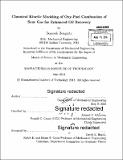Chemical kinetic modeling of oxy-fuel combustion of sour gas for enhanced oil recovery
Author(s)
Bongartz, Dominik
DownloadFull printable version (21.71Mb)
Other Contributors
Massachusetts Institute of Technology. Department of Mechanical Engineering.
Advisor
Ahmed F. Ghoniem.
Terms of use
Metadata
Show full item recordAbstract
Oxy-fuel combustion of sour gas, a mixture of natural gas (primarily methane (CH 4 )), carbon dioxide (CO 2 ), and hydrogen sulfide (H 2 S), could enable the utilization of large natural gas resources, especially when combined with enhanced oil recovery (EOR). Chemical kinetic modeling can help to assess the potential of this approach. In this thesis, a detailed chemical reaction mechanism for oxy-fuel combustion of sour gas has been developed and applied for studying the combustion behavior of sour gas and the design of power cycles with EOR. The reaction mechanism was constructed by combining mechanisms for the oxidation of CH4 and H2S and optimizing the sulfur sub-mechanism. The optimized mechanism was validated against experimental data for oxy-fuel combustion of CH4, oxidation of H2S, and interaction between carbon and sulfur species. Improved overall performance was achieved through the optimization and all important trends were captured in the modeling results. Calculations with the optimized mechanism suggest that increasing H2 S content in the fuel tends to improve flame stability through a lower ignition delay time. Water diluted oxy-fuel combustion leads to higher burning velocities at elevated pressures than CO 2 dilution or air combustion, which also facilitates flame stabilization. In a mixed CH4 and H2S flame, H25 is oxidized completely as CH4 is converted to carbon monoxide (CO). During CO burnout, some highly corrosive sulfur trioxide (SO3 ) is formed. Quenching of SO 3 formation in the combustor can only be achieved at the expense of higher CO emissions. The modeling of a gas turbine cycle showed that oxy-fuel combustion leads to SO 3 concentrations that are one to two orders of magnitude lower than in air combustion and will thus suffer much less from the associated corrosion problems. Slightly fuel-rich operation is most promising for achieving the low CO and oxygen (02) concentrations required for EOR while further minimizing SO 3. Carbon dioxide dilution is better for achiving low 02 in the EOR stream while H20 gives the better combustion efficiency.
Description
Thesis: S.M., Massachusetts Institute of Technology, Department of Mechanical Engineering, 2014. Cataloged from PDF version of thesis. Includes bibliographical references (pages 135-147).
Date issued
2014Department
Massachusetts Institute of Technology. Department of Mechanical EngineeringPublisher
Massachusetts Institute of Technology
Keywords
Mechanical Engineering.